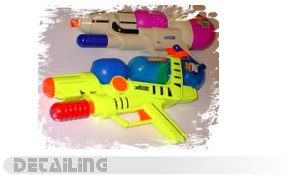The colour of original water weaponry often makes it difficult to remain camouflaged in bushes or trees. Others may simply want to personalize their favourite weapons. In any case, while the design and detailing is up to the user, a few key points should be remembered when glorifying one's weaponry:
- avoid making it look like a real gun (though the shape of most water blasters do not resemble the shape of any real fire-arm, it is best not to take chances, especially if ever caught in the sights of a police officer.)
- cover the nozzle, trigger, water reservoir cap, pumping mechanism and any other moveable part with tape to prevent them from being jammed up by the paint
- do not use water soluble paint (for obvious reasons)
- avoid filling in screw holes and air holes (especially in the CPS 1000 and CPS 1500)
- the back of the blaster tends to get the most wear (since it is closest to the body when the blaster is being used). This painted area can be protected by adding a layer of clear packing tape
Not only does painting personalize one's water blaster, but it can also seriously intimidate one's inexperienced opponents. ...besides, only a watergun-maniac would paint their blasters, right?! ...RIGHT!
DETAILING: Not all may wish to recolour their weapons and paint can actually get expensive depending on type and amounts needed. One can also personalize one's weapon by detailing it with water-insoluble markers or paint.
 Water
blasters tend to be made up of moulded plastic with many features which
disappear since they are all made of the same coloured plastic. To make
one's weapon look a little more stunning, key areas of the plastic should
be highlighted (usually by colouring regions using a black marker/paint).
Water
blasters tend to be made up of moulded plastic with many features which
disappear since they are all made of the same coloured plastic. To make
one's weapon look a little more stunning, key areas of the plastic should
be highlighted (usually by colouring regions using a black marker/paint).